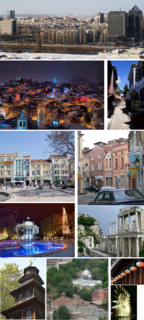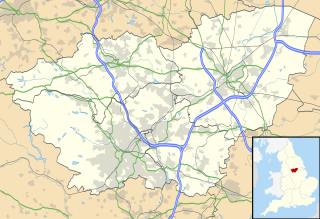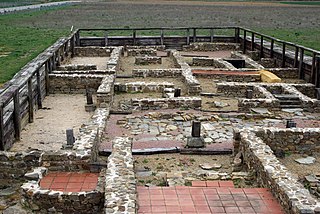
Plovdiv is the second-largest city in Bulgaria, standing on the banks of the Maritsa river in the historical region of Thrace. It has a population of 346,893 as of 2018 and 675,000 in the greater metropolitan area. Plovdiv is the cultural capital of Bulgaria and was the European Capital of Culture in 2019. It is an important economic, transport, cultural, and educational center. During most of its recorded history, Plovdiv was known by the name Philippopolis after Philip II of Macedon.

Novae was initially one of the few great Roman legionary fortresses along the empire's border, forming part of the defences along the Danube in northern Bulgaria. The settlement later expanded into a town in the Roman province of Moesia Inferior, later Moesia Secunda.

Templeborough is a suburb of Rotherham, South Yorkshire, England. The suburb falls within the Brinsworth and Catcliffe ward of Rotherham Metropolitan Borough Council. The area takes its name from the remains of the Roman fort found there which were mistakenly believed to be that of a Roman Temple.
Oescus, Palatiolon or Palatiolum was an important ancient city on the Danube river in Roman Moesia. It later became known as Ulpia Oescus. It lay northwest of the modern Bulgarian city of Pleven, near the village of Gigen.

Devnya is a town in Varna Province, Northeastern Bulgaria, located about 25 km away to the west from the city of Varna and The Black Sea Coast. It is the administrative centre of the homonymous Devnya Municipality. As of December 2009, the town has a population of 8,383 inhabitants.

Kabile, Cabyle, or Kabyle is a village in southeastern Bulgaria, part of the Tundzha municipality, Yambol Province.
Sinitevo is a village in central Bulgaria. It is located 5 km. east of Pazardzhik. As of 2005 the population was 2160. It is located at an altitude of 200 metres (660 ft) in a fertile agricultural region near the Maritsa river. The main products grown in the area include wheat, maize, peppers, while the most spread domestic animal is the sheep.

Beklemeto Pass, also known as Troyan Pass, is a mountain pass in the Balkan Mountains in Bulgaria. It connects Troyan and Karnare on the Karlovo Plain.

Carrawburgh is a settlement in Northumberland. In Roman times, it was the site of a 3+1⁄2-acre (1.5 ha) auxiliary fort on Hadrian's Wall called Brocolitia, Procolita, or Brocolita. This name is probably based on the Celtic name for the place, and one possible translation put forward is 'badger holes'. The fort there was a mile or so west of the Wall's northernmost point at Limestone Corner, and just over a mile west of the nearest milecastle, Milecastle 30. The fort either used the Wall itself as its northern rampart, or was built parallel to it but detached. It certainly postdates both the Wall and the vallum.

Ratiaria was a city founded by the Moesians, a Daco-Thracian tribe, in the 4th century BC, along the river Danube. In Roman times it was named Colonia Ulpia Traiana Ratiaria.
The city of Plovdiv is situated in southern Bulgaria. During its long history it has been conquered by numerous peoples: Thracians, Macedon, Romans, Byzantines, Bulgarians, Ottoman Turks which contributed to the city's various historical heritage.
Praetorium Agrippinae was a Roman settlement in the province of Lower Germania, in the area of the Cananefates, located in modern-day Valkenburg, Netherlands. It was an army encampment on the Old Rhine, on the northern border of the Roman Empire, the limes. Praetorium Agrippinae is mentioned on the Tabula Peutingeriana between the castella of Matilo in the east and Lugdunum Batavorum to the west.

Slack Roman Fort was a castellum near Outlane, to the west of Huddersfield in West Yorkshire, England. Its site is a scheduled monument. The ruins of the fort which lay alongside the Pennine section of the Roman road from Deva Victrix (Chester) to Eboracum (York) are no longer visible. The fort may have been the Cambodunum mentioned as a station on this route in the Antonine Itinerary.

Rapidum was a Roman settlement and fort located in Mauretania Caesariensis, nearly 100 km south of Icosium (Algiers).
Cohors prima Ulpia Dacorum was an infantry regiment of the Auxilia corps of the Imperial Roman army. It was founded by the Roman emperor Trajan, probably in preparation for his planned war against Parthia (113-6). The regiment's honorific title Ulpia refers to the emperor's gens, or clan-name.

Philippopolis is one of the names of the ancient city situated where Plovdiv is today. The city became one of the largest and most important in region and was called "the largest and most beautiful of all cities" by Lucian. During most of its recorded history, the city was known by the name Philippopolis after Philip II of Macedon. Philippopolis became part of the Roman empire and capital of the Roman province of Thracia. According to Ammianus Marcellinus, Philippopolis had a population of 100,000 in the Roman period.

Petavonium was a Roman Legionary Fortress (castrum) of the Legio X Gemina, and later a Roman city formed from the canabae, or civilian camp. It was located in the valley of Vidriales in an area of the modern Santibanez de Vidriales and its hamlet Rosinos de Vidriales, in the province of Zamora.
Cohors tertia Ulpia Petraeorum [sagittaria] [milliaria] [equitata] was a Roman auxiliary cohort of infantry and cavalry.












